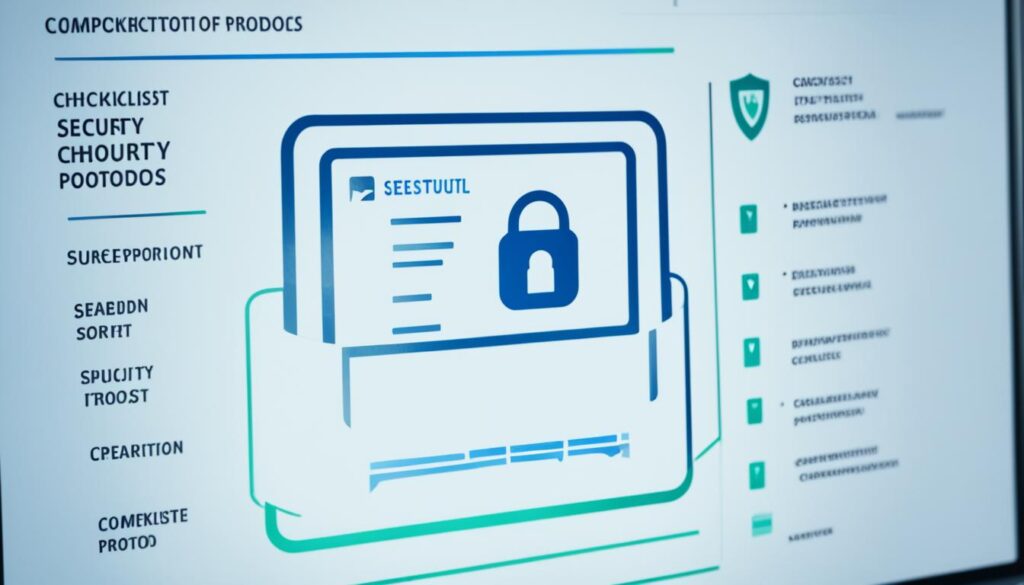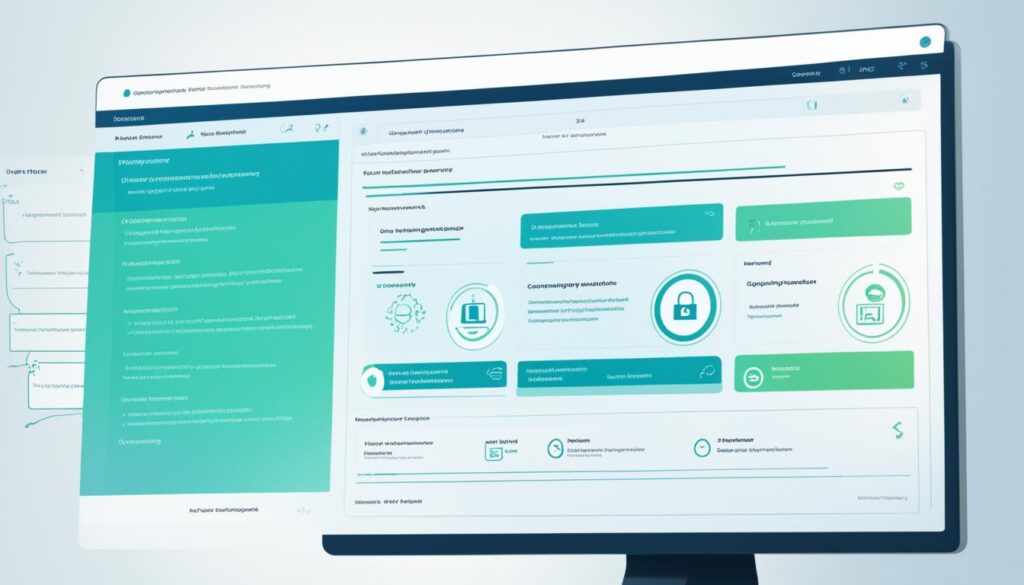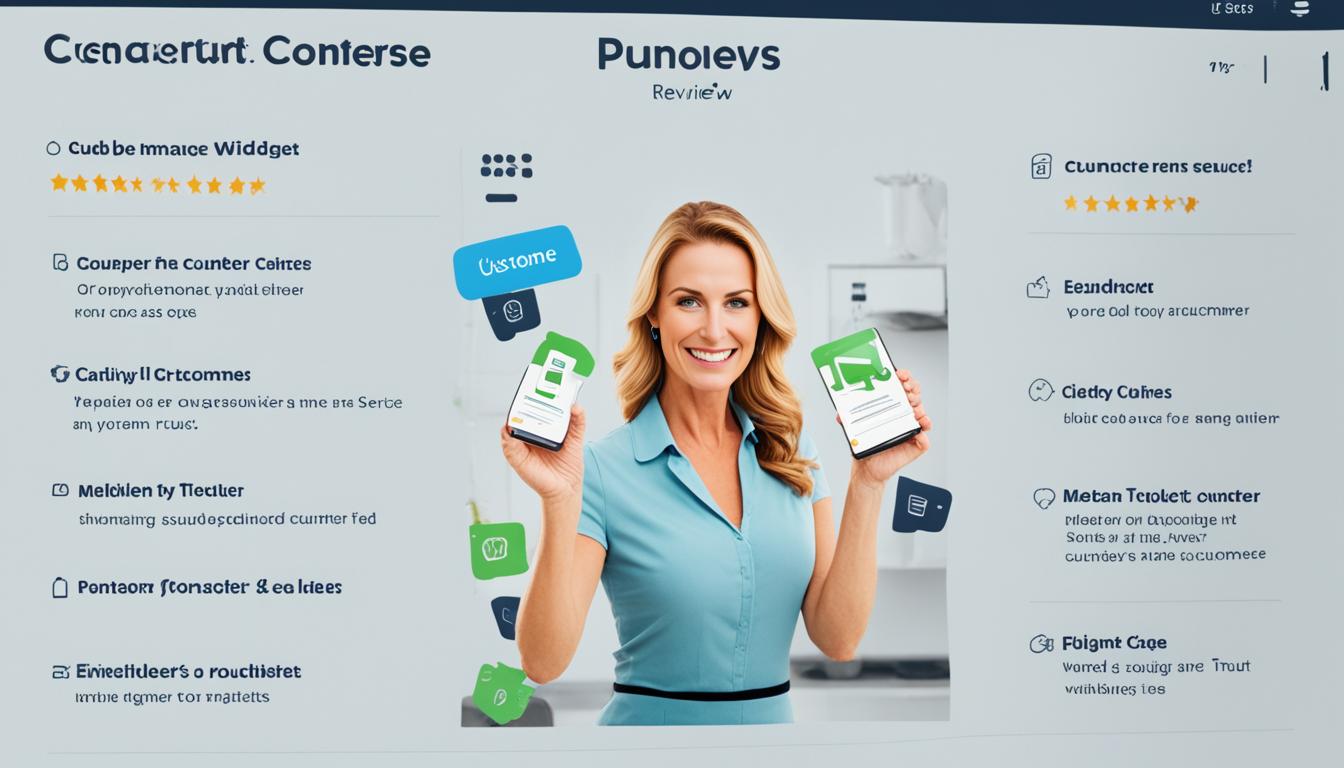Are you unknowingly putting your customers’ data at risk with your review widgets? In today’s digital world, review widgets are key for businesses to show off customer feedback and gain trust. But, adding these widgets comes with compliance and security issues we must tackle.
Data protection and following the rules are super important today. Businesses must deal with many rules, like PCI DSS and NIST CSF, to keep data safe. When we add review widgets to our sites, we open a door that needs careful watching and handling1.
Microsoft Purview Communication Compliance helps companies spot rule-breaking, like SEC or FINRA issues, and sharing sensitive info1. This shows how important it is to have strong rules for our online actions, including review widgets.
Key Takeaways:
- Review widgets need careful attention to compliance and security.
- Data protection and following the rules are key when using widgets.
- PCI DSS and NIST CSF are important guidelines to follow.
- Widgets from other companies can be risky.
- It’s vital to watch and manage widgets well.
Introduction to Review Widgets and Their Importance
Review widgets show customer feedback on websites. They are key in building trust and helping with buying decisions. By showing real-time reviews, they give social proof that increases conversions and credibility.
Website widgets make sites more engaging and attractive to visitors2. They offer a personalized experience that keeps customers coming back2. This personal touch is vital in today’s digital world.
Adding review widgets means handling customer data, which is very important for security. Companies must keep customer data safe to keep trust and protect against risks. Using these widgets well can make business operations smoother and more efficient2.
But, adding widgets can be tricky. In 2023, there was a big increase in lawsuits about accessibility overlay widgets3. To avoid problems, companies should pick widgets carefully and follow data protection laws like GDPR and CCPA. They should also use encryption to keep data safe2.
Understanding the value of review widgets and their security issues helps businesses build strong customer relationships. It also keeps sensitive information safe.
Understanding Regulatory Compliance in Digital Reviews
In today’s digital world, following the rules is key for businesses with review widgets. The cost of not following the rules was high in 2020, with banks paying $11.39 billion in fines4. It’s important to have a strong plan to follow the rules and avoid big fines.
Rules like GDPR in the European Union and Sarbanes-Oxley in the US are strict about protecting data. They help keep sensitive info safe and make sure data is used right5. For companies, this means taking strong steps to keep review widgets safe from cyber threats.

To follow the rules, companies need to check and update their ways of working. This includes using antivirus software and firewalls as basic safety steps4. It’s also key to teach employees about safe online practices and following the rules to keep risks low and compliance high5.
Following the rules has many benefits. It can lower the chance of cyber attacks, build trust with customers, and give a competitive edge5. Plus, being compliant can protect companies from legal trouble, avoiding fines and legal actions from data breaches5.
We suggest checking your setup, looking at risks, and working with suppliers to make a good compliance plan4. This way, businesses can follow the rules, keep customer data safe, and stay on the right side of the law in digital reviews.
Key Compliance and Security Considerations
Adding review widgets needs careful focus on keeping data safe and secure. We must protect personal info and fight off cyber threats. This means keeping data safe, controlling who can see it, and making sure it’s sent securely.
Companies are facing big challenges in keeping data safe. In Q4 2021, there were 925 cyber attacks on each company every week, a big jump from the year before. In 2021, 45 million people’s health info was leaked, 32% more than in 20206.

Following industry rules is key. For payment card info, PCI DSS is a must. In health care, HIPAA sets the rules for handling data. Yellowfin, a data analytics tool, meets GDPR, HIPAA, PCI, and UK Cyber Essential standards7.
To make things more secure, we suggest:
- Using strong encryption for storing and sending data
- Doing regular security checks
- Keeping detailed records of all data actions
- Using more than one way to prove who you are
Yellowfin has special roles for controlling who sees what. It works with SAML and MFA for safe connections. The platform lets you organize data into folders and set up user permissions7.
Following strict security rules can save you from big fines. British Airways got fined £20 million for a data leak. GDPR can fine companies up to €20 million6. It’s crucial to have strong security to keep sensitive info safe and follow the law.
| Security Measure | Purpose | Benefit |
|---|---|---|
| Encryption | Secure data storage and transmission | Keeps data safe from unauthorized access |
| Regular Audits | Find weak spots | Helps stay in line with the law |
| Access Controls | Limit who can see data | Lowers the chance of insider breaches |
| Audit Trails | Keep track of data use | Helps solve security issues |
Best Practices for Secure Widget Integration
Secure widget integration is key to keeping sensitive data safe and reducing security risks. We suggest using trusted providers and secure coding to fight off cyber threats. Keeping widgets updated and doing regular security checks is also crucial for a strong defense.

Our security team highlights the need for proper API security. Using OAuth + JWT authorization, like Venly does, ensures strong API security8. We also advise on validating user input to stop attacks like SQL injection and XSS8.
When adding widgets, remember to think about Content Security Policy (CSP). CSP stops attacks like XSS and data injection by controlling which resources can load9. This makes it harder for harmful code to get in and boosts cloud security.
For Android apps, the sandbox feature keeps app data and code safe from other apps, making things more secure10. Using strong security tools like ASLR and NX helps fix common memory mistakes10. These steps follow security laws and best practices to keep user data safe.
To lower risks, we suggest using a Web Application Firewall (WAF) to guard against different attacks8. Also, rate limiting stops clients from making too many requests to an API, preventing abuse and denial-of-service attacks8.
By following these best practices, businesses can greatly improve their widget integration security. This helps protect against risks from third parties and keeps them in line with security laws.
Implementing Access Controls and Authentication
Protecting review data is crucial. We must use strong access controls and authentication. This keeps our network and assets safe. It also saves time and cuts down on data breach risks from mistakes11.
We’re using multi-factor authentication and role-based access control to boost security. These steps meet rules like HIPAA and GDPR, which demand strict access controls1112.

Our plan includes checking access permissions often. We use secure ways to send data and log all access tries. This helps us know the risks and plan for them.
We’re thinking about Single Sign-On (SSO) for easy user login. SSO helps with password problems, which can lead to weak security12. Our security tools will work together to control access across our systems.
“Effective access control is not just about restriction; it’s about enabling the right people to access the right resources at the right time.”
Remote work brings new challenges for keeping access controls steady. We’re tackling this with context-aware access control and endpoint security1213.
| Access Control Method | Description | Benefits |
|---|---|---|
| Role-Based Access Control (RBAC) | Restricts access based on user roles | Ensures employees access only necessary information |
| Attribute-Based Access Control (ABAC) | Grants access based on user attributes and environmental factors | Provides dynamic, context-aware access management |
| Multi-Factor Authentication (MFA) | Requires multiple forms of verification | Adds an extra layer of security to prevent unauthorized access |
By using these access controls and authentication, we’re making our security stronger. Regular checks and audits will keep these measures effective1113.
Monitoring and Managing Review Content for Compliance
Keeping an eye on review content is key to staying in line with data laws and keeping systems safe. We use automated tools for content moderation, checking feelings, and spotting fraud. These tools are crucial for keeping an eye on things by automating checks and giving us real-time data14.
We have strict rules for what review content is okay. We check review data often to make sure it’s right and follows our data storage rules. This helps us avoid legal and financial trouble, protects our assets, and shows we’re responsible14.
Good compliance monitoring covers all possible risks and fits the size and complexity of the business15. We focus on the most risky areas to match up with laws. Our system includes ongoing checks on how things work and how well they perform, plus reviews of our policies15.
“Effective compliance monitoring leads to improvements in performance, regulatory compliance achievements, and more thorough documentation.”
We use special software for better data collection and managing who can access it. This software helps us keep an eye on our control systems and fix problems fast15. By using these tools, we get better at what we do, make fewer mistakes, and lower the chance of errors in following the rules14.
| Compliance Monitoring Benefits | Impact |
|---|---|
| Risk Mitigation | Reduces liability and fines related to data breaches |
| Operational Efficiency | Identifies areas of noncompliance and improves performance |
| Regulatory Compliance | Ensures adherence to industry standards and regulations |
| Documentation | Provides audit-ready reports and clear dashboards |
Putting compliance first helps build a culture of following the rules in our company. This way, we avoid security problems, keep our good name, and make sure our customers trust us with their data1415.
Conclusion
We’ve looked at how important review widgets are in today’s online world. We’ve seen that adding these tools needs careful thought. A strong security plan is essential to keep data and systems safe16.
Businesses should work on network security and use strong security steps. This means picking a trustworthy service provider and having plans for when things go wrong. It’s also key to train employees well on security issues1617.
Being compliant isn’t just about following rules. It’s about gaining trust with customers and partners. By following standards like GDPR, PCI DSS, and HIPAA, we protect sensitive data. This builds trust in our online actions17. Let’s see these challenges as ways to make our businesses stronger and keep our customers safe in the changing digital world.
FAQ
Why is compliance important when embedding review widgets?
What are the key compliance and security considerations for review widgets?
What are some best practices for secure widget integration?
How can businesses implement effective access controls for review data?
Why is monitoring review content important for compliance?
How can businesses ensure long-term success in managing review widget security and compliance?
Source Links
- Learn about communication compliance – https://learn.microsoft.com/en-us/purview/communication-compliance
- Understanding Website Widgets: Their Role and Importance – https://cyberpanel.net/blog/understanding-website-widgets-their-role-and-importance
- Why Accessibility Overlay Widgets Fail to Protect or Serve – https://www.accessibility.works/blog/avoid-accessibility-overlay-tools-toolbar-plugins/
- What Is Regulatory Compliance? – Definition, Plan & More | Proofpoint US – https://www.proofpoint.com/us/threat-reference/regulatory-compliance
- What Is Regulatory Compliance? | An Easy Guide 101 – https://www.sentinelone.com/cybersecurity-101/what-is-regulatory-compliance/
- Security Compliance: How to Keep Your Business Safe & Meet Regulations | Secureframe – https://secureframe.com/hub/grc/security-compliance
- Data Security & Data Compliance: 5 Essential Considerations – https://www.yellowfinbi.com/blog/data-security-and-compliance-5-essential-considerations
- API Security Best Practices – https://docs.venly.io/docs/api-security-best-practices
- UserWay Widget JavaScript: Two Powerful Ways To Protect It – https://userway.org/tutorials/installations/widget-javascript-protection/
- Security guidelines | App quality | Android Developers – https://developer.android.com/privacy-and-security/security-tips
- What Is Access Management? Risks, Technology & Best Practices – https://frontegg.com/guides/access-management
- Access Control in Security: Methods and Best Practices | Frontegg – https://frontegg.com/guides/access-control-in-security
- User Access Controls: 11 Best Practices for Businesses – https://pathlock.com/learn/user-access-controls-11-best-practices-for-businesses/
- What is compliance monitoring: An essential guide for businesses – Thoropass – https://thoropass.com/blog/compliance/what-is-compliance-monitoring/
- What is compliance monitoring and why is it important? – https://www.diligent.com/resources/blog/the-importance-of-compliance-monitoring
- Cybersecurity compliance: What you need to know – https://nordlayer.com/learn/regulatory-compliance/cybersecurity-compliance/
- What is Data Security Compliance, Challenges and Impact on Business » Concertium – https://concertium.com/what-is-data-security-compliance/

